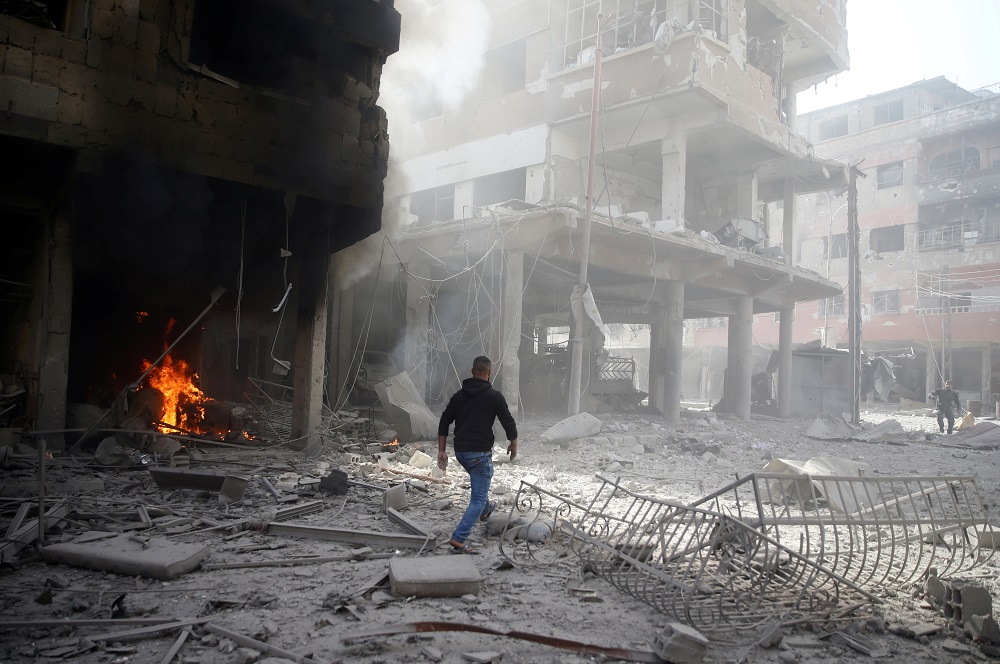March 15, 2018

For the past seven years, the Simon-Skjodt Center for the Prevention of Genocide has worked to raise awareness of the crimes against humanity and war crimes perpetrated against Syrian men, women, and children—primarily by the Assad regime and its allies—in order to drive policy discussions around civilian protection in Syria, highlight survivors and civil society leaders who are working to save lives, and support accountability for atrocity crimes.
In January 2018, Simon-Skjodt Center staff traveled to Jordan and the Turkey-Syria border to assess ongoing and future risks to civilians in Syria. Our assessment—drawn from interviews with UN officials, US government officials, NGO staff, Syrian civil society organizations, and Syrian refugees in Amman, Istanbul, and Gaziantep—is compiled in our new report, “Is the Worst Yet to Come? Ongoing Mass Atrocity Risks in Syria.” The key finding of the report states that, “at a moment when Assad is brutally regaining control of opposition-held areas and the international community speaks of an end to fighting and to future stabilization and reconciliation, the worst may be yet to come for Syrian civilians.”
Other key findings of the report include:
- The Assad regime—emboldened by its Russian and Iranian allies and a lack of consequences for the commission of atrocities—believes that it is on the cusp of winning this phase of the war and will continue to target civilians until it has achieved its goal of maintaining power or is stopped.
- Civilians in opposition-controlled areas face heightened risks of mass atrocities, particularly in Eastern Ghouta and Idlib province.
- Civil society in opposition-controlled areas that come under government control face a unique and serious risk. The fear of detention in regime-controlled areas will continue to serve as a deterrent to people returning over the long run.
- As the conflict enters a new phase, where Assad has reasserted his control over substantial parts of the country, shifting demographic and power dynamics set the stage for future conflicts, particularly in areas controlled by the Syrian Democratic Forces and in areas under regime control.
The report argues that though there are fewer options for civilian protection seven years after the start of the conflict, there are still actions that the international community can take, "Protecting civilian populations must be a primary priority of any Syria policy discussion, no less urgent than other near-term political interests or long-term strategic interests."
Recommendations for the international community:
- Develop and consider a new comprehensive strategy involving a full range of coercive and non-coercive responses to protect civilians, reinforced by a common political strategy that reflects evolving threats;
- Pressure and compel the guarantors of the de-escalation agreements—Russia, Turkey, and Iran—to:
- force the Syrian government to comply with the terms of the agreements and United Nations Security Council Resolution 2401;
- call on neighboring countries to open their borders to Syrians fleeing attacks;
- push for humanitarian access to besieged and hard-to-reach communities
- Compel the Assad regime to release those arbitrarily detained and reveal the fate and location of those subject to enforced disappearance;
- Provide continued support to civil society, both in opposition-held areas and outside of Syria, to continue their life-saving work;
- Advance accountability to help ensure justice for victims and end the current culture of impunity.
For more information on the Simon-Skjodt Center’s work on Syria, visit the Museum’s YouTube page.
To learn more about the war in Syria and the impact on civilians, visit our Syria case page.
View All Blog Posts